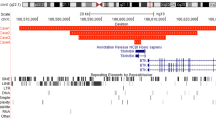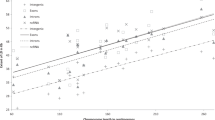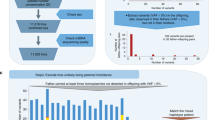Abstract
Menkes disease is an X–linked recessive disorder of copper metabolism resulting in death in early infancy. The gene has been mapped to band Xq13 based, in part, on a translocation breakpoint in a female with the disease, which was found to lie within 300 kilobases (kb) of the PGK–1 locus, allowing the isolation of a YAC clone spanning the breakpoint. Phage subclones from the breakpoint region were isolated and used to screen cDNA libraries. cDNA clones were found which detect an 8 kb transcript from normal individuals but show diminished or absent hybridization in Menkes disease patients. Partial sequence of the cDNA shows a unique open reading frame containing putative metal binding motifs which have been found in heavy metal resistance genes in bacteria. This gene is a strong candidate for the Menkes disease gene.
This is a preview of subscription content, access via your institution
Access options
Subscribe to this journal
Receive 12 print issues and online access
$209.00 per year
only $17.42 per issue
Buy this article
- Purchase on Springer Link
- Instant access to full article PDF
Prices may be subject to local taxes which are calculated during checkout
Similar content being viewed by others
References
Menkes, J.H., Alter, M., Steigleder, G.K., Weakley, D.R. & Sung, J.H. A sex-linked disorder with retardation of growth, peculiar hair and focal cerebral arid cerebellar degeneration. Pediatrics 29, 764–779 (1962).
Danks, D.M. et al. Menkes' Kinky hair syndrome. Lancet 1, 1100–1102 (1972).
Danks, D.M. in Metabolic Basis of inherited Disease. (eds Scriver, C.R. et al.) 1411–1462 (Me Graw Hill, New York, 1989).
Kapur, S., Higgins, J.V., Delph, K. & Rogers, B. Menkes Syndrome in a girl with X-autosome translocation. Am. J. med. Genet. 26, 503–510 (1987).
Tonnesen, T., Peterson, A., Kruse, T.A., Gerdes, A.-M. & Horn, N. Am. J. hum. Genet. 50, 1012–1017 (1992).
Keer, J.T. et al. Genetic mapping in the region of the mouse inactivation center. Genomics 7, 566–572 (1990).
Verga, V. et al. Localization of the translocation breakpoint in a female with Menkes syndrome to Xq13.2-q13.3 proximal to PGK-1. J. hum. Genet. 48, 1133–1138 (1991).
Green, E. D. & Olson, M.V. Systematic screening of yeast artificaial-chromosome libraries by use of the polymerase chain reaction. Proc. natn. Acad. Sci. U.S.A. 87, 1213–1217 (1990).
Pieretti, M., Tonlorenzi, R. & Ballabio, A. Rapid assembly of lambda contigs within YAC clones. Nucl. Acids Res. 19, 2795–2796 (1991).
Saburo, S., Shanske, S., Salvatore, D.-M. & Schon, E.A. Isolation of a cDNA encoding the B isozyme of human phosphoglycerate mutase (PGAM) and charavterization of the PGAM gene family. J. biol. Chem. 263, 16899–16705 (1988).
Turner, Z. et al. Characterization of a 1.0 MB YAC contig spanning two chromosome breakpoints related to Menkes disease. Hum. molec. Genet. 483–489 (1992).
Gonsales, G.G. et al. Fine mapping and cloning of the breakpoint associated clone with Menkes syndrome in a female patient. Genomics 14, 557–561 (1992).
Silver, S. & Misra, T.K. Plasmid-mediated heavy metal resistances. Ann. Rev. Microbiol. 42, 717–743 (1988).
Brown, N.L. et al. Bacterial resistances to mercury and copper. Cell. Biochem. 46, 106–114 (1991).
Silver, S. et al. Bacterial resistance ATPases: primary pumps for exporting toxic cations and anions. TIBS 14, 76–80 (1989).
Camakaris, J. et al. Altered copper metabolism in cultured cells from Menkes syndrome and mottled mouse mutants. Biochem. Genet. 18, 117–131 (1980).
Sambrook, J., Fritsch, E.F. & Maniatis, T. Molecular Cloning, A Laboratory Manual 2nd edn (Cold Spring Harbor Laboratory Press, New York, 1989).
Piechaczyk, M. et al. Post transcriptional regulation of glyceraldehyde-3-phosphate dehydrogenase gene expression in rat tissues. Nucl. Acids Res. 12, 6951–6963 (1984).
Keith, D.H., Singer-Sam, J. & Riggs, A.D. Active X-chromosome DNA is unmethylated at eight CCGG sites clustered in a guanine-plus-cytosine rich island at the 5′ end of the gene for phosphoglycerate kinase. Molec. cell Biol. 6, 4122–4125 (1986).
Kuwano, A. & Kajii, T. High-resolution banding in chromosomes of B lymphoblastoid cells and cultured skin fibroblasts. Cytogenet. Cell Genet. 56, 212–213 (1991).
Franco, B. et al. A gene deleted in Kallmann's syndrome shares homology with neural cell adhesion and axonal path-finding molecules. Nature 353, 529–536 (1991).
Lengauer, C., Green, E.D. & Cremer, T. Fluorescence in situ hybridization of YAC clones after Alu-PCR amplification. Genomics 13, 826–828 (1992).
Devereux, J., Haeberli, P. & Smithies, O. A comprehensive set of sequence analysis programs for the VAX. Nucl. Acids Res. 12, 387–395 (1984).
Author information
Authors and Affiliations
Rights and permissions
About this article
Cite this article
Mercer, J., Livingston, J., Hall, B. et al. Isolation of a partial candidate gene for Menkes disease by positional cloning. Nat Genet 3, 20–25 (1993). https://doi.org/10.1038/ng0193-20
Received:
Accepted:
Issue Date:
DOI: https://doi.org/10.1038/ng0193-20
This article is cited by
-
Pharmacokinetics of CuGTSM, a Novel Drug Candidate, in a Mouse Model of Menkes Disease
Pharmaceutical Research (2021)
-
Copper is an essential regulator of the autophagic kinases ULK1/2 to drive lung adenocarcinoma
Nature Cell Biology (2020)
-
Identification of novel ATP7A mutations and prenatal diagnosis in Chinese patients with Menkes disease
Metabolic Brain Disease (2017)



